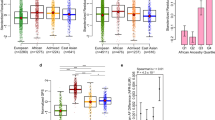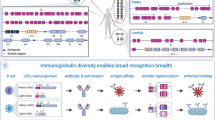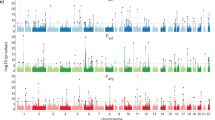Abstract
Understanding the molecular regulation of immunoglobulin A (IgA) expression is important as it plays an essential role in the first-line defence through mucosal secretions. Using inbred mouse strains, we identified two independent and dominant acting genetic loci that synergistically cause a 40-fold upregulation in serum IgA levels when introduced into the murine strain C57Bl/6J (B6). The first locus on chromosome 12 appears to be mainly responsible for the natural four-fold higher IgA levels in C3HeB/FeJ (C3H) compared to B6 mice. A second independent, chemically induced mutation on chromosome 5 caused a two-fold elevation when transferred from C3H into B6 mice. Both loci in concert effect a 40-fold elevation against the B6 genetic background. We determined the chromosomal localization of the two loci simultaneously by a one-step mapping process. The chemically induced mutation was identified within the immunoglobulin joining chain (IgJ) gene on chromosome 5. The major serum IgA modifier between the C3H and B6 was located on chromosome 12. This modifier region was mapped to a 350 kb region containing several immunoglobulin heavy-chain genes and the Igα germline switch gene. We speculate that by interfering with both IgA expression and distribution, synergistic regulation of IgA is achieved.
This is a preview of subscription content, access via your institution
Access options
Subscribe to this journal
Receive 6 digital issues and online access to articles
$119.00 per year
only $19.83 per issue
Buy this article
- Purchase on Springer Link
- Instant access to full article PDF
Prices may be subject to local taxes which are calculated during checkout



Similar content being viewed by others
References
van Egmond M, Damen CA, van Spriel AB, Vidarsson G, van Garderen E, van de Winkel JG . IgA and the IgA Fc receptor. Trends Immunol 2001; 22: 205–211.
Johansen FE, Braathen R, Brandtzaeg P . The J chain is essential for polymeric Ig receptor-mediated epithelial transport of IgA. J Immunol 2001; 167: 5185–5192.
Braathen R, Sorensen V, Brandtzaeg P, Sandlie I, Johansen FE . The carboxyl-terminal domains of IgA and IgM direct isotype-specific polymerization and interaction with the polymeric immunoglobulin receptor. J Biol Chem 2002; 277: 42755–42762.
Lycke N, Erlandsson L, Ekman L, Schon K, Leanderson T . Lack of J chain inhibits the transport of gut IgA and abrogates the development of intestinal antitoxic protection. J Immunol 1999; 163: 913–919.
Hendrickson BA, Rindisbacher L, Corthesy B et al. Lack of association of secretory component with IgA in J chain-deficient mice. J Immunol 1996; 157: 750–754.
Stavnezer J . Immunoglobulin class switching. Curr Opin Immunol 1996; 8: 199–205.
Coffman RL, Lebman DA, Rothman P . Mechanism and regulation of immunoglobulin isotype switching. Adv Immunol 1993; 54: 229–270.
Manis JP, Tian M, Alt FW . Mechanism and control of class-switch recombination. Trends Immunol 2002; 23: 31–39.
Jung S, Rajewsky K, Radbruch A . Shutdown of class switch recombination by deletion of a switch region control element. Science 1993; 259: 984–987.
Hein K, Lorenz MG, Siebenkotten G, Petry K, Christine R, Radbruch A . Processing of switch transcripts is required for targeting of antibody class switch recombination. J Exp Med 1998; 188: 2369–2374.
Harriman GR, Bradley A, Das S, Rogers-Fani P, Davis AC . IgA class switch in I alpha exon-deficient mice. Role of germline transcription in class switch recombination. J Clin Invest 1996; 97: 477–485.
Lee CG, Kinoshita K, Arudchandran A, Cerritelli SM, Crouch RJ, Honjo T . Quantitative regulation of class switch recombination by switch region transcription. J Exp Med 2001; 194: 365–374.
Sayegh CE, Quong MW, Agata Y, Murre C . E-proteins directly regulate expression of activation-induced deaminase in mature B cells. Nat Immunol 2003; 4: 586–593.
Korstanje R, Paigen B . From QTL to gene: the harvest begins. Nat Genet 2002; 31: 235–236.
Erlandsson L, Akerblad P, Vingsbo-Lundberg C, Kallberg E, Lycke N, Leanderson T . Joining chain-expressing and -nonexpressing B cell populations in the mouse. J Exp Med 2001; 194: 557–570.
Hendrickson BA, Conner DA, Ladd DJ et al. Altered hepatic transport of immunoglobulin A in mice lacking the J chain. J Exp Med 1995; 182: 1905–1911.
Simpson EM, Linder CC, Sargent EE, Davisson MT, Mobraaten LE, Sharp JJ . Genetic variation among 129 substrains and its importance for targeted mutagenesis in mice. Nat Genet 1997; 16: 19–27.
Fernandes PR, Samuelson DA, Clark WR, Cousins RJ . Immunohistochemical localization of cysteine-rich intestinal protein in rat small intestine. Am J Physiol 1997; 272 (4 Part 1): G751–G759.
Cousins RJ, Lanningham-Foster L . Regulation of cysteine-rich intestinal protein, a zinc finger protein, by mediators of the immune response. J Infect Dis 2000; 182 (Suppl 1): S81–S84.
Lanningham-Foster L, Green CL, Langkamp-Henken B et al. Overexpression of CRIP in transgenic mice alters cytokine patterns and the immune response. Am J Physiol Endocrinol Metab 2002; 282: E1197–E1203.
Peters T, Thaete C, Wolf S et al. A mouse model for cystinuria type I. Hum Mol Genet 2003; 12: 2109–2120.
Acknowledgements
We thank Andrea Koppius, Kerstin Kronthaler and Natalia Savitskaia for expert technical assistance.
Author information
Authors and Affiliations
Corresponding author
Rights and permissions
About this article
Cite this article
Schneider, B., Hanke, P., Jagla, W. et al. Synergistic interaction of two independent genetic loci causes extreme elevation of serum IgA in mice. Genes Immun 5, 375–380 (2004). https://doi.org/10.1038/sj.gene.6364105
Received:
Revised:
Accepted:
Published:
Issue Date:
DOI: https://doi.org/10.1038/sj.gene.6364105



